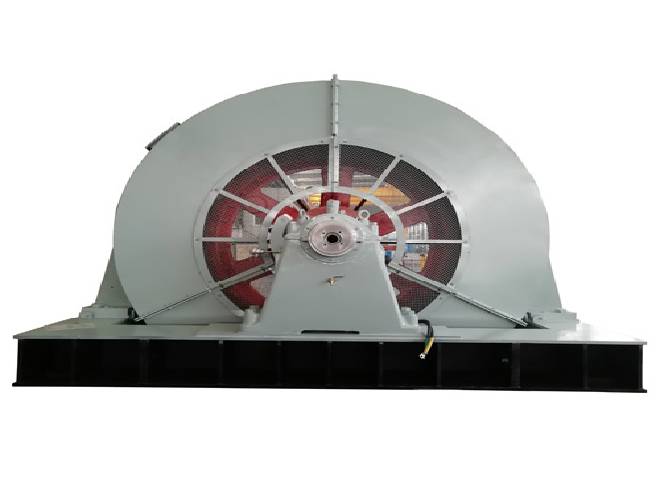The working principle of Electric Motors: There are many forms of electric motors, but their working principles are based on the law of electromagnetic induction and the law of electromagnetic force. Therefore, the general principle of its construction is: use appropriate magnetic and conductive materials to form magnetic circuits and circuits that conduct electromagnetic induction with each other to generate electromagnetic power and achieve the purpose of energy conversion.
A three-phase asynchronous motor is an induction motor. After current is applied to the stator, part of the magnetic flux passes through the short-circuit loop and induces current in it. The current in the short-circuit ring hinders the change of the magnetic flux, so that the magnetic flux generated by the part with the short-circuit ring and the part without the short-circuit ring has a phase difference, thereby forming a rotating magnetic field. After power-on, the rotor windings induce electromotive force and current due to the relative motion between the rotor and the magnetic field, that is, the rotating magnetic field and the rotor have a relative speed, and interact with the magnetic field to generate electromagnetic torque, which makes the rotor rotate and realize energy conversion.
Classification of motors:
1. Classified by working power
According to the different working power of the motor, it can be divided into DC motor and AC motor. Among them, AC motors are also divided into single-phase motors and Three-Phase Motor.
2. Classified by structure and working principle
According to the different structure and working principle of the motor, it can be divided into DC motor, asynchronous motor and synchronous motor.
3. Synchronous motors can also be divided into permanent magnet synchronous motors, reluctance synchronous motors and hysteresis synchronous motors.
4. Asynchronous motors can be divided into induction motors and AC commutator motors. Induction motors are divided into three-phase asynchronous motors, single-phase asynchronous motors and shaded-pole asynchronous motors. AC commutator motors are divided into single-phase series motors, AC and DC motors and repulsion motors.
According to the structure and working principle, DC motors can be divided into brushless DC motors and brushed DC motors. Brushed DC motors can be divided into permanent magnet DC motors and electromagnetic DC motors. Electromagnetic DC motors are divided into series-excited DC motors, shunt-excited DC motors, separately-excited DC motors and compound-excited DC motors. Permanent magnet DC motors are divided into rare earth permanent magnet DC motors, ferrite permanent magnet DC motors and Alnico permanent magnet DC motors.

Synchronous Motors
5. Classified by starting and running mode
According to the different starting and operating modes of the motor, it can be divided into capacitor-starting single-phase asynchronous motors, capacitor-operating single-phase asynchronous motors, capacitor-starting single-phase asynchronous motors and split-phase single-phase asynchronous motors.
6. Classified by purpose
Can be divided into driving motors and control motors.
6.1 The driving motor is divided into electric tools (including drilling, polishing, polishing, grooving, cutting, reaming and other tools) motors, household appliances (including washing machines, electric fans, refrigerators, air conditioners, tape recorders, video recorders, etc.) Motors for DVD players, vacuum cleaners, cameras, hair dryers, electric shavers, etc.) and motors for other general small mechanical equipment (including various small machine tools, small machinery, medical equipment, electronic instruments, etc.).
6.2 Motors for control are further divided into stepping motors and servo motors.
7. According to the structure of the rotor
According to the structure of the rotor, the motor can be divided into a squirrel cage induction motor (the old standard is called a squirrel cage induction motor) and a wound rotor induction motor (the old standard is called a wound induction motor).
8. Classified by operating speed
According to the different operating speeds of motors, they can be divided into high-speed motors, low-speed motors, constant-speed motors, and speed-regulating motors.
8.1 Low-speed motors are divided into gear reduction motors, electromagnetic reduction motors, torque motors and claw-pole synchronous motors.
8.2 In addition to variable speed motors can be divided into stepped constant speed motors, stepless constant speed motors, stepped variable speed motors and stepless variable speed motors, it can also be divided into electromagnetic speed control motors, DC speed control motors, and PWM variable frequency speed control motors. And switched reluctance speed motor.
9. The rotor speed of the asynchronous motor is always slightly lower than the synchronous speed of the rotating magnetic field.
10. The rotor speed of the Synchronous Motors has nothing to do with the size of the load and always maintains the synchronous speed.
Copyright © ZCL Electric Motor Technology Co., Ltd. All Rights Reserved | Sitemap | Powered by 